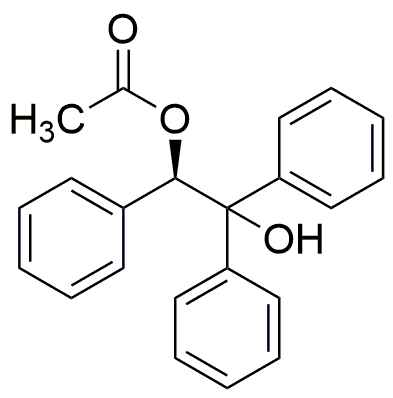(R)-(+)-1,1,2-Triphenyl-1,2-ethanediol 2-acetate is widely utilized in research focused on:
- Pharmaceutical Development: This compound serves as an important intermediate in synthesizing various pharmaceuticals, particularly in the development of chiral drugs that require specific stereochemistry for efficacy.
- Chiral Catalysis: It plays a significant role in asymmetric synthesis, where it acts as a chiral auxiliary, enhancing the selectivity and yield of desired products in chemical reactions.
- Material Science: The compound is used in the formulation of specialized materials, such as polymers and resins, that benefit from its unique structural properties, leading to improved performance in applications like coatings and adhesives.
- Biochemical Research: Researchers utilize this compound to study enzyme interactions and mechanisms, providing insights into biological processes and aiding in the development of enzyme inhibitors.
- Analytical Chemistry: It is employed as a standard in chromatographic techniques, allowing for the accurate quantification of other compounds in complex mixtures, which is crucial for quality control in various industries.
General Information
Properties
Safety and Regulations
Applications
(R)-(+)-1,1,2-Triphenyl-1,2-ethanediol 2-acetate is widely utilized in research focused on:
- Pharmaceutical Development: This compound serves as an important intermediate in synthesizing various pharmaceuticals, particularly in the development of chiral drugs that require specific stereochemistry for efficacy.
- Chiral Catalysis: It plays a significant role in asymmetric synthesis, where it acts as a chiral auxiliary, enhancing the selectivity and yield of desired products in chemical reactions.
- Material Science: The compound is used in the formulation of specialized materials, such as polymers and resins, that benefit from its unique structural properties, leading to improved performance in applications like coatings and adhesives.
- Biochemical Research: Researchers utilize this compound to study enzyme interactions and mechanisms, providing insights into biological processes and aiding in the development of enzyme inhibitors.
- Analytical Chemistry: It is employed as a standard in chromatographic techniques, allowing for the accurate quantification of other compounds in complex mixtures, which is crucial for quality control in various industries.
Documents
Safety Data Sheets (SDS)
The SDS provides comprehensive safety information on handling, storage, and disposal of the product.
Product Specification (PS)
The PS provides a comprehensive breakdown of the product’s properties, including chemical composition, physical state, purity, and storage requirements. It also details acceptable quality ranges and the product's intended applications.
Certificates of Analysis (COA)
Search for Certificates of Analysis (COA) by entering the products Lot Number. Lot and Batch Numbers can be found on a product’s label following the words ‘Lot’ or ‘Batch’.
*Catalog Number
*Lot Number
Certificates Of Origin (COO)
This COO confirms the country where the product was manufactured, and also details the materials and components used in it and whether it is derived from natural, synthetic, or other specific sources. This certificate may be required for customs, trade, and regulatory compliance.
*Catalog Number
*Lot Number
Safety Data Sheets (SDS)
The SDS provides comprehensive safety information on handling, storage, and disposal of the product.
DownloadProduct Specification (PS)
The PS provides a comprehensive breakdown of the product’s properties, including chemical composition, physical state, purity, and storage requirements. It also details acceptable quality ranges and the product's intended applications.
DownloadCertificates of Analysis (COA)
Search for Certificates of Analysis (COA) by entering the products Lot Number. Lot and Batch Numbers can be found on a product’s label following the words ‘Lot’ or ‘Batch’.
*Catalog Number
*Lot Number
Certificates Of Origin (COO)
This COO confirms the country where the product was manufactured, and also details the materials and components used in it and whether it is derived from natural, synthetic, or other specific sources. This certificate may be required for customs, trade, and regulatory compliance.


